World without water: six solutions to a shortage
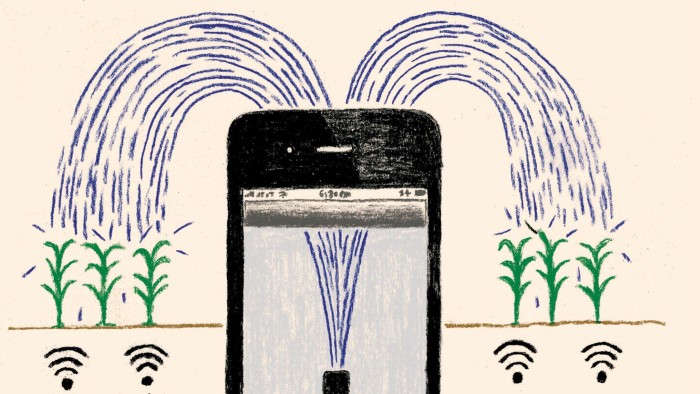
Simply sign up to the US & Canadian companies myFT Digest -- delivered directly to your inbox.
The World Bank is planning to devote up to $5bn a year to try to fix it. Goldman Sachs says it poses a risk to economic growth. And Matt Damon, the actor, has tipped a bucket of toilet water over his head to bring attention to it.
The problem is water — a vital resource that has long been poorly managed or taken for granted in much of the world and that has rising populations driving competition for supplies. The search for solutions to uneven and inadequate water supply has already led to improvements in irrigation, desalination and wastewater recycling, and is spurring development of innovative technologies such as waterless fracking in the energy industry and more water-saving devices at home.
But the scale of the problem remains vast. There are already 2bn people living in countries with absolute water scarcity, according to the World Bank, which estimates the number will rise to 4.6bn by 2080. The dilemma is especially acute in China, India and other large emerging economies, which companies are relying on for future growth. Hence the growing attention of banks such as Goldman Sachs.
These countries are also home to many of the 780m people who still lack readily available clean and safe drinking water, the predicament that charities such as Mr Damon’s Water.org are trying to highlight. As he said this year, just before being filmed dousing himself in toilet water: “For those of you who, like my wife, think this is really disgusting, keep in mind that the water in our toilets in the west is actually cleaner than the water that most people in the developing world have access to.”
Even in wealthier regions, the time may come when the idea of using fresh water for such a purpose will seem bizarre. In drought-stricken California, hundreds of people in East Porterville have had dry taps for months this year. People in Hong Kong have been flushing with seawater for decades as authorities try to preserve scarce fresh supplies. But poorer countries are still struggling to make such improvements.
If only there was a way to, say, produce water from thin air. Or stop farmers, the biggest users of water, drenching fields with old-fashioned irrigation systems. Or ship water from a place like Iceland (population: 320,000) to somewhere like Iran (population: 76m), where officials think more than a third of the country’s 31 provinces may have to be evacuated because of water shortages over the next 20 years.
These are just some of the ideas that are starting to make their way from drawing board to factory floor, as investors show more interest in ventures that preserve or enhance water supplies.
“We are seeing the emergence of a surprising constellation of different types of investors, such as oil and gas companies, and very wealthy families putting their money into water technologies,” says Tom Whitehouse, chairman of the London Environmental Investment Forum, an advisory business that connects investors with new clean technologies. “There are huge water scarcity problems across the world which have to be solved and water is also becoming a strategic issue.”
FT series

An investigation into how businesses are having to adapt to rising water costs around the world
Energy companies are driving investment in treatment and desalination technologies, as they expand in regions with scarce supplies. They are among the biggest contributors to the $84bn that companies around the world have spent since 2011 to improve the way they obtain, manage or conserve water.
Food and beverage groups are also spending more to cut their water use.
In October, Nestlé unveiled a milk plant in Mexico it has spent more than $15m upgrading that it claims is the first of its kind: it does not need external water sources but recycles waste fluid extracted from milk when powdered. Domestically, the shower, the washing machine and the toilet are also being reinvented.
Here, we look at some of the water technologies that are starting to come on stream. Some are already on the market. Others are in development and some sound too far fetched to ever come true. But all are designed to address a problem that shows little sign of fading.
***
Making water from air
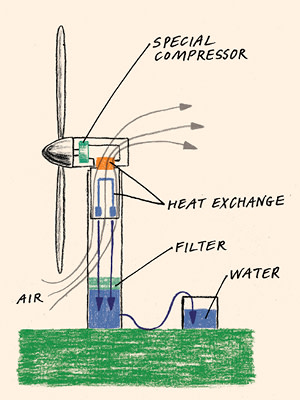
Most wind turbines generate electricity but a Dutch company has found a way to make them produce water from air instead. Dutch Rainmaker’s device looks like a typical turbine, except for two boxlike containers at its base that house a water collection tank, and a heat exchange and condenser system.
The turbine forces air through heat exchangers, where the air is cooled by ammonia compressors, a little like those in a household fridge. As the water in the air condenses, it forms droplets that are collected in a storage tank. The company has had two prototypes in operation for two years, one in the Netherlands and the other in Kuwait, which are producing an average of 7,000 litres a day of water — without any electricity.
“It’s completely self-sustainable, which means there is virtually no maintenance,” says Mike O’Connor, chief executive of Dutch Rainmaker.
The technology requires wind, a temperature of at least 10C and humidity of around 10 per cent. The company says this means it can operate through most of the year in the many countries where water is scarce.
The system is not cheap. Mr O’Connor says the company expects to sell it for roughly the same price as a small desalination machine, which can range in price from $400,000 to $1m. It hopes to make its first sale by the end of the year.
Waterless fracking
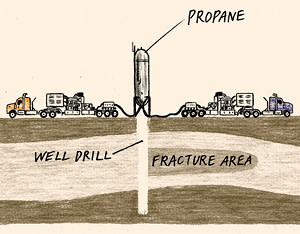
The US shale boom is underpinned by advances in hydraulic fracturing, or fracking, which requires a lot of water, typically around 2m gallons or more per well. The amount of water needed spells trouble in spots where supplies are tight. According to one study published earlier this year, nearly 40 per cent of the oil and gas wells drilled since 2011 in the US are in areas of extremely high water stress.
That has led to a search for waterless fracking and one of the pioneers in the field is Gasfrac Energy Services, an eight-year-old Canadian company that has developed a system that mixes sand with gelled propane, butane and other hydrocarbons, instead of water.
“We’ve fracked over 2,400 wells,” says Jason Munro, Gasfrac’s president. “Nobody is on location when we frack, it’s all done remotely. We’re one of the safest fracking companies in the world,” he says. “You have to be. It’s a volatile fluid that we’re using.”
Gasfrac counts several large energy companies as customers. As pressure grows on supplies, an industrywide shift to waterless fracking is likely to intensify.
Shipping water
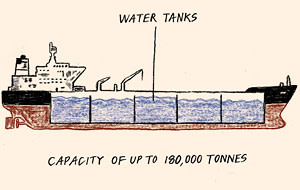
The idea of shipping water in vast quantities from soggy countries to parched ones sounds like an obvious solution to water scarcity.
Now an Icelandic company, Bruarfoss, claims to be ready to create a new global export industry that would see water shipped around the world to specialised port terminals, similar to those that handle shipments of liquefied natural gas.
It is now working on a plan to deliver glacial spring water from Iceland in supertankers that can carry up to 180,000 tonnes at a time.
Birgir Vidar Halldorsson, founder of Bruarfoss, says the plan still faces some challenges, such as a lack of suitable harbours and terminals with facilities capable of handling bulk water shipments. “Hopefully we can start building the infrastructure here,” he says. “At the same time there will be infrastructure built in maybe two, three or four countries in the coming years so we can park and fill their terminals.”
Mr Halldorsson says the company is looking at working with other groups that want to build vessels for such a project, and it claims there is interest from potential customers in the Middle East.
The waterless toilet
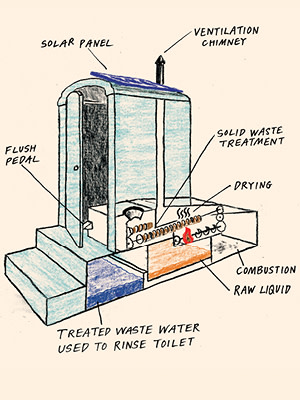
The humble lavatory has not changed much since the first flush toilet patent was issued in 1775. But the waterless toilet is on its way. Several groups are working on such a device, partly thanks to funding from the Bill and Melinda Gates Foundation, which is trying to improve poor sanitation conditions that each year contribute to the deaths of some 700,000 children from diarrhoea.
One of them, RTI International, a US research institute, is developing a system that not only needs no water, but generates electricity as well. The toilet captures waste, then separates it into liquids and solids. Urine and other
liquids are disinfected through an electrochemical process and the treated water can then be used to rinse the toilet.
Solid faeces material is dried and broken into pellets, which can then be burnt in a device that captures some of the heat and converts it into electricity that powers the water treatment process.
RTI is already testing a prototype in Gujarat, India. The Gates Foundation wants such systems to cost less than five cents per user per day, which RTI says it hopes to be able to meet as it scales up the technology.
The almost waterless washing machine
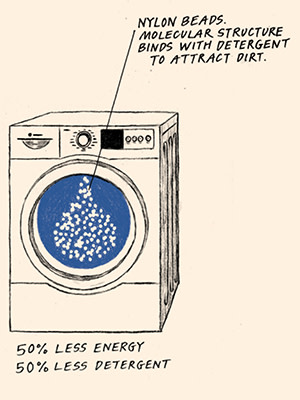
A British company called Xeros is transforming the automatic washing machine — an appliance that has changed little in 60 years — with technology that uses thousands of polymer beads to remove stains from clothes. The molecular structure of the beads combines with detergent to attract dirt. They can be used for hundreds of washes before being recycled.
Xeros claims its machines use 70 per cent of the water, 50 per cent of the energy and 50 per cent of the detergent consumed in conventional washing machines. Its products are already being used in big laundries in the US, where customers include several hotel groups. Xeros has 37 installed and ordered machines in the US, and seven in Europe.
Xeros is working on a domestic version of the machine it hopes will be available in late 2016. The price tag for that? “In terms of costs, these have not as yet been concretely defined but are expected to be around the same as premium washing machines on the market,” it says.
Smart irrigation
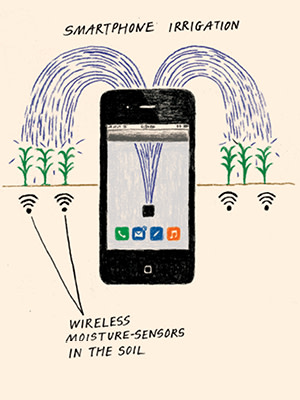
Humans have been irrigating crops for as long as they have been growing plants. One of the earliest forms of the practice — flood irrigation — remains in widespread use. It involves pumping or diverting water to fields so it flows along the ground among the crops. It is simple and cheap, but inefficient and wasteful.
Several companies are working on smarter systems, including Switzerland’s Plantcare, which says it has devised an automated watering technology that allows a farmer to irrigate with much more precision and less waste.
“You can run it from an iPhone,” says Walter Schmidt, a physicist who founded the company. Fields are dotted with sensors that can detect minute changes in soil moisture. They relay information wirelessly to a computer, which calculates how much water the plants can absorb.
Fields are lined with water pipes that run along the crops. Each pipe has valves that can be directed to open and close according to how much water is needed. Data from the computer can be sent via SMS messages to a smartphone, allowing farmers to reset the system if needed, or receive an alarm if there is a problem.
The system is already in use in several European countries, and some users say it has boosted yields by 30 per cent and cut water use by 50 per cent. Mr Schmidt has visited India to look at developing a scaled-down version.
Pilita Clark won the Environment Story of the Year award at the Foreign Press Association in London’s Media Awards 2014 for the Financial Times series, ‘A World Without Water’.
Illustrations by Alex Robbins
——————————————-
Letter in response to this article:
Under-investment is denying people access to usable water / From Jack Moss
Comments